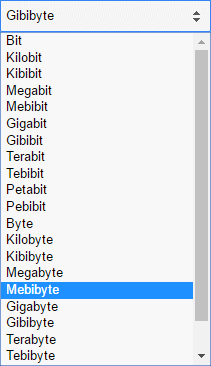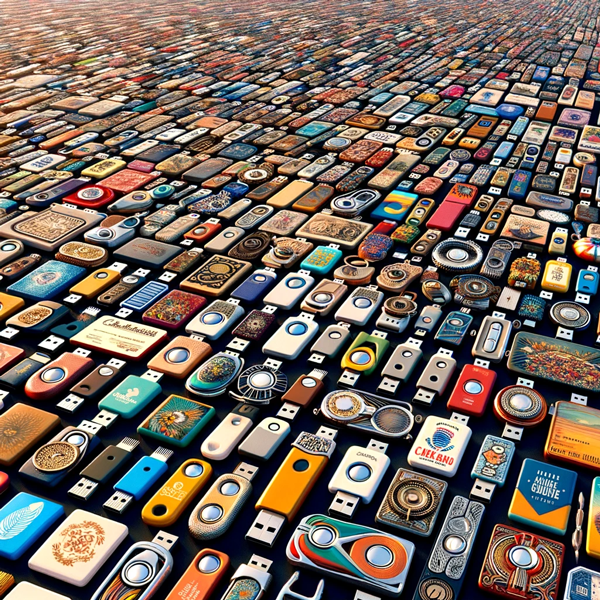This seems like a simple question to answer, but we actually get asked this all the time. It’s kind of understandable when you take into account the many uses our customers find for custom flash drives.
Figuring Out the USB Stick Storage Capacity
We need to ask some qualifying questions to determine the ideal capacity of a USB flash drive, as there are many factors that will influence the chosen storage space.
These questions could include: “What is the purpose of your flash drive? Materials distribution? Tradeshow handout? Corporate gift? Is the flash more function-oriented or promotional?”
Obviously, you want to buy a memory capacity that will fit the data that you are planning to load onto the drive. But there are cases that lead to increasing the memory capacity beyond your minimum requirement.
Photographers like to order 8, 16 & 32GB capacities or more because different shoots result in varying quantities of photos. Continuing education conference planners many times have 15 – 30 talks and materials with a pdf from each speaker that range from around 10MB – 100MB in size. A 1GB flash drive would hold those materials for the most part. But in nearly every case the purchaser will order at least a 2GB memory capacity. It’s a “just in case” type of scenario that might have saved them from headaches in the past. And for the time being, there’s a difference of a few pennies from a 1GB to a 2GB upgrade for your bulk custom flash drive order, making it a no-brainer.
Ultimately, there are many factors that will influence your decision regarding USB drive storage capacity. One of the best things about flash drives today is the amount of storage space that these devices can carry while still maintaining portability. Some flash drives are capable of storing as much as 128GB, which is a huge difference from the limited USB sticks in the past.
Get Help Deciding on USB Flash Memory Capacity
We’ve got a decent amount of experience identifying the size of your data and guiding you to your options with regard to capacity choice. Give us a call at 866-458-8415. A salesperson would be happy to help you Find Your Drive™ at Every USB. We’ll help with product selection based on your specific needs. You’ll be able to find the perfect flash drive for storing nearly any type of data, whether you want to include preloaded data or simply intend to use them for personal file storage.
Question: Why don’t I receive 4GBs of space when I order a 4GB custom flash drive?
Answer: Because Gigabytes don’t actually exist in a computer.
Whaaaa? Yup. You read that correctly. Gigabytes, Megabytes, Kilobytes are all numbers based on the decimal system: our 1 – 10 way of counting that everyone knows and loves. Computers are based on the binary system of digits. There are only 8 digits to complete the cycle, so… 1 – 8 and then you start over again. If you’re not a math wiz, and there is a real good chance that you are not. (Don’t worry, you’re in good company with the person writing this.) Then you’re probably already lost. Not a problem…
Here are some calculators to let you convert how much data you have and if it will fit within the custom flash drive capacity that you intend on purchasing. Like the image below, select all of the files and/or folders that you want to have loaded on the custom flash drive. Right-click on your selection and select properties. Go to the link below and enter the entire number of bytes as displayed on your computer. Here is a screenshot of what this looks like in Windows 10…

Convert Bytes(B) to Gibibytes(GiB)
When we visit the link above, which converts Bytes(B) to Gibibytes(GiB) and we enter the number of bytes from the example screenshot above, which is 79,764,550 Bytes, we see the following conversion…

Since the amount of data is far less than 1GB. It displays a decimal of 1GiB. We can use the unit selector on the right-hand side to give us Mebibytes instead of Gibibytes to make the number more easily readable. The selector looks like this…

And it results in a final value that looks like this…

Technical Information
First a key to the numbers.
Decimal (Marketable Gigabytes):
1 G = 10^9 = 1,000,000,000
1 M = 10^6 = 1,000,000
1 K = 10^3 = 1,000
These are the correct prefixes under the SI standards.
Binary (used by the OS for bytes):
1 GiB = 2^30 bytes = 1,073,741,824 bytes
1 MiB = 2^20 bytes = 1,048,576 bytes
1 KiB = 2^10 bytes = 1,024 bytes
These are the correct units for binary though by convention we drop the “i” and use the SI names.
The formula to figure actual capacity in GiB is: GB listed * 10^9 / 2^30 = calculated capacity
Calculated capacity – Overhead = Usable Capacity
Note: Overhead is inaccessible space on a formatted drive and will vary slightly but can be as much as 100 MB
128 GB * 10^9 / 2^30 bytes = ~119.21 GiB
256 GB * 10^9 / 2^30 bytes = ~234.42 GiB
Summary
Using the manufacturer’s numbers and the calculated numbers give us:
1GB: 0.94GB stated usable capacity: ~0.93GiB calculated capacity
2GB: 1.86GB stated usable capacity: ~1.86GiB calculated capacity
4GB: 3.79GB stated usable capacity: ~3.73GiB calculated capacity
8GB: 7.51GB stated usable capacity: ~7.45GiB calculated capacity
16GB: 15GB stated usable capacity: ~14.9GiB calculated capacity
32GB: 29.7GB stated usable capacity: ~29.8GiB calculated capacity
64GB: 59.53GB stated usable capacity: ~59.60GiB calculated capacity
128GB: no stated usable capacity: ~119.21GiB calculated capacity
256GB: no stated usable capacity: ~234.42GiB calculated capacity
Regardless of the USB drive storage capacity you need, we’ll help you find the right drive with enough space to store files of all types. Whether you want to use them to hold image files or run applications, we have a wide selection of custom flash drive options that can give you what you need.
